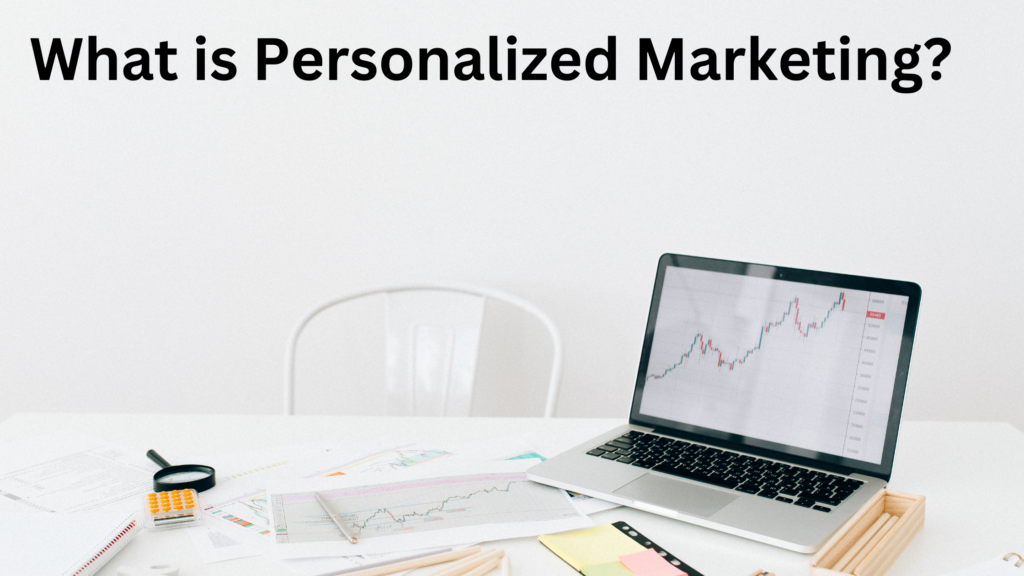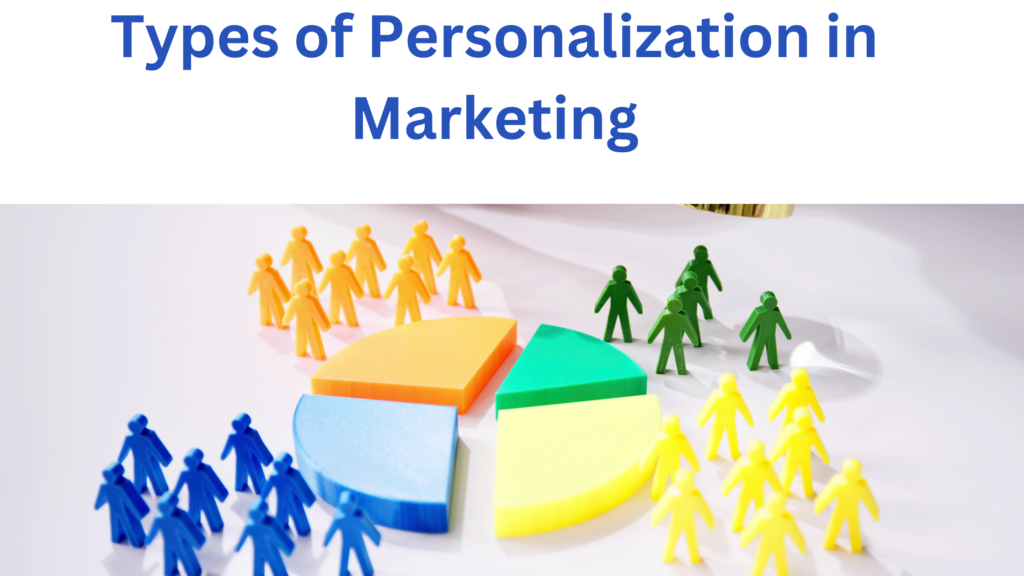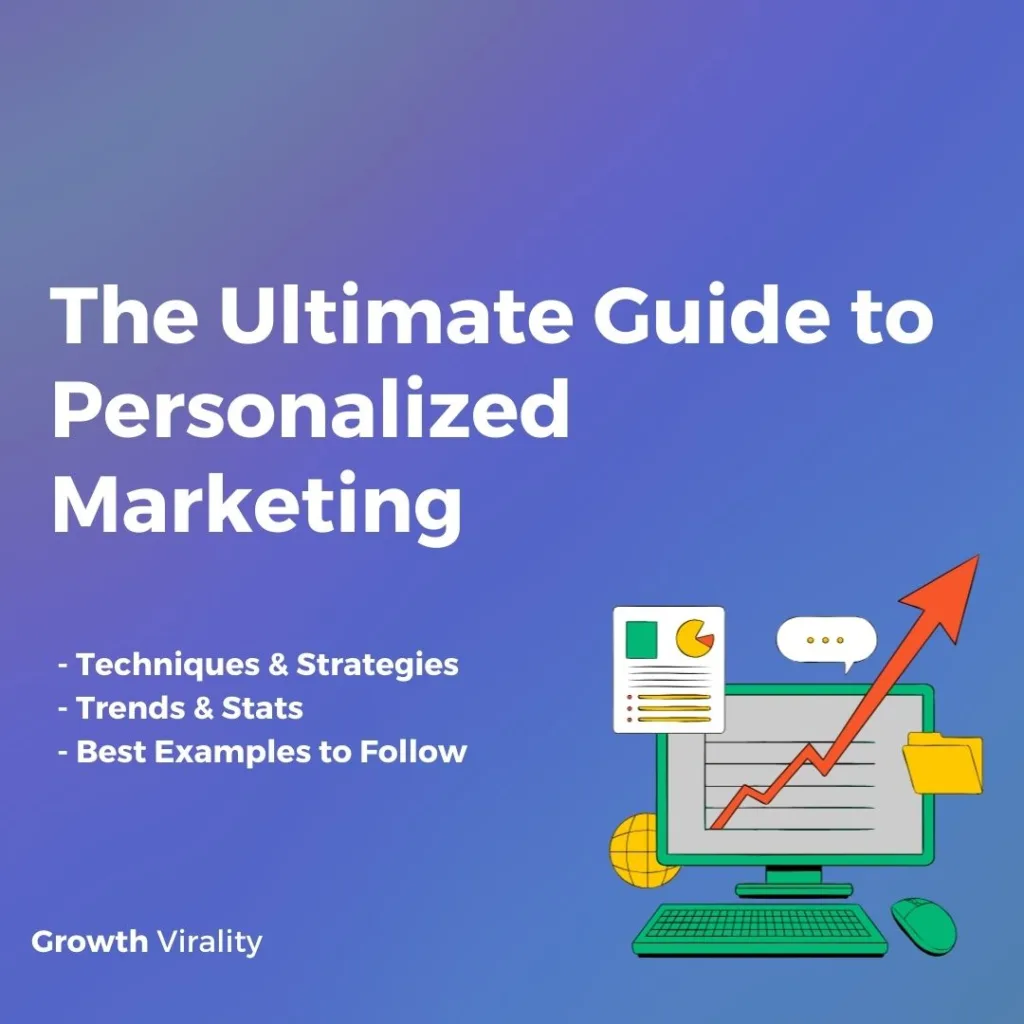If someone understands your likes and dislikes, you’re likely to stick around, right?
The same goes for brands. When they show they know and appreciate you through personalized marketing, it builds a strong connection and loyalty.
Personalized marketing gives companies that cool factor. They stand out by meeting customer expectations in a world where personalized experiences are the name of the game.
Let’s find out what personalized marketing is and how you can create a customized marketing plan for your brand to acquire more loyal customers.
What is Personalized Marketing?

Personalized marketing is a unique strategy companies employ to customize content and experiences for each customer. This tailoring is rooted in understanding buyer personas and the entire customer journey, enabling businesses to nurture leads effectively.
The key characteristics of customized marketing are:
- Making each customer feel special by tailoring marketing to their unique preferences. Using customer data to understand how they behave and what they like.
- Grouping people into specific categories to send them content that suits their interests. Personalizing messages based on a customer’s past actions and behaviors.
- Changing content in real-time to match individual preferences and behaviors.
- Creating custom content and experiences for each customer using data.
- Going beyond the first interaction and guiding customers through the entire buying process.
- Ensuring a consistent and smooth personalized experience on different marketing channels.
- Using automation tools and artificial intelligence to personalize marketing efforts efficiently.
- Understanding and tailoring experiences for customers at every step of their journey.
- Regularly improving personalization strategies based on customer feedback and performance.
- Tweaking messages or recommendations instantly based on what the customer is doing or needs.
Also See: Powerful MarCom Software To Grow Your Brand
What is the Need For Personalized Marketing?
Personalized marketing has several advantages and benefits that help businesses earn customer appreciation and recognition.
- Making marketing messages fit each person’s needs boosts how happy they are and what they think of the brand.
- Customized messages grab attention, making people more likely to interact and respond.
- Personalizing messages to match what makes each customer unique gives more significance to the communication.
- Adjusting marketing to suit individual interests increases the chance of turning potential customers into actual buyers.
- Tailoring experiences creates loyalty and keeps customers around for the long term.
- Personalized marketing meets the desires of today’s customers, who expect experiences tailored to their preferences.
- Looking at customer data helps make smart and personalized marketing strategy choices.
- Showing a real understanding of customers through personalization creates trust in the brand.
Current Personalization Trends For 2024
- Continually integrating AI and machine learning for proactive and predictive personalization strategies, ensuring adaptability.
- Nurturing repeat engagement, loyalty, and precision in behavioral targeting through thoughtful and personalized marketing initiatives.
- Enhancing email open rates by integrating personalized subject lines, showcasing the tangible impact of personalized communication.
- Brands are adopting a personalized “one-on-one” approach, utilizing technology to cultivate deeper and more meaningful connections.
- Moving away from conventional generic advertising methods to prevent customer frustration and annoyance, embracing more personalized approaches.
- Utilizing customer data to offer tailored product recommendations heightens the suggested items’ relevance and appeal.
- Moving away from conventional generic advertising methods to prevent customer frustration and annoyance, embracing more personalized approaches.
- Utilizing customer data to offer tailored product recommendations heightens the suggested items’ relevance and appeal.
- Pioneering personalized experiences for anonymous visitors, recognizing the significance of personalization even for users who opt not to sign in.
- Tailoring email subject lines to resonate directly with each recipient, ensuring a more engaging and personalized communication style.
- Utilizing image recognition to decipher colors and patterns enhances the quality of personalized product suggestions.
- Expanding personalization efforts beyond specific interactions, crafting smooth and tailored experiences across the customer journey.
- Aligning strategies with the increasing customer demand for personalized experiences in a dynamic market.
- Moving away from traditional generic ads to prevent customer frustration and irritation, ushering in a more personalized and engaging approach.
Also See: Best Influencer Marketing Tools List
Personalization Marketing Challenges
Customer Trust and Transparency
Fostering and nurturing customer trust through transparent communication about data usage, ensuring an open dialogue, and obtaining explicit consent for personalization endeavors.
Technology Integration
Skillfully weaving together a tapestry of diverse technologies for effective personalization, encompassing customer relationship management (CRM) systems, AI tools, and data analytics platforms.
Consistent Cross-Channel Personalization
Crafting a seamless and coherent personalized journey across various channels and touchpoints, upholding consistency in messaging and brand representation.
Content Relevance and Adaptability
Forging content that remains pertinent and flexible in line with evolving customer preferences, ensuring personalized messages deeply resonate with the target audience.
Personalization at Scale
Scaling up personalization endeavors to encompass a larger audience without compromising the quality of tailored experiences, often necessitating advanced automation and AI solutions.
Algorithm Bias and Fairness
Addressing biases within algorithms employed for personalization, ensuring impartial and just treatment across diverse customer segments, and sidestepping any form of discrimination.
Overcoming Personalization Fatigue
Safeguarding customers from the onset of personalization fatigue, where excess customization might lead to disengagement or the perception of unwarranted intrusion.
Dynamic Consumer Behavior
Adapting to the ever-shifting terrain of consumer behavior, preferences, and market trends, demanding agility in personalization strategies to remain pertinent and effective.
Types of Personalization in Marketing

Website Personalization
When we talk about website personalization, it means changing what you see on a website, like the content, product suggestions, and how things look, to match what you like and have done on the site before.
Here is how you can use personalization on your website:
- Organize website visitors into different segments by considering demographics, behavior, and preferences.
- Keep a close eye on user actions, interactions, clicks, and browsing patterns to gain valuable insights.
- Conduct data analysis to identify patterns and preferences, guiding personalized content strategies.
- Tailor the website experience by dynamically adapting content, images, and recommendations to suit each user personally.
- Offer product suggestions that align with a user’s history and preferences for a more personalized touch.
- Customize calls-to-action to match user interests or current engagement levels.
- Personalize content according to the user’s geographical location to ensure enhanced relevance.
- Split your audience to experiment with different personalized elements for optimization.
- Collect and utilize user feedback to refine and improve personalization strategies.
- Implement real-time updates to the website based on evolving user behavior.
Also See: Leading Growth Marketing Channels
Dynamic Content Personalization
Dynamic content customization is like changing things on a website, such as pictures, words, or special deals, in real time. It does this based on what the user is doing, where they are, or other things that can change.
Use these best practices for dynamic content customization:
- Utilize dynamic content modules that can adapt based on user behavior and preferences.
- Implement rules and triggers to display content relevant to the user’s journey or actions.
- Integrate data sources to update content, ensuring accuracy and dynamic timeliness.
- Personalize headlines, images, and calls to action based on user segments and interactions.
- Leverage machine learning algorithms to predict and serve content aligned with user interests.
- Test different variations of dynamic content to optimize engagement and conversion rates.
- Incorporate real-time user data to adjust content dynamically during the user’s visit.
- Offer personalized recommendations and suggestions within dynamically changing content.
- Customize content based on the user’s past interactions and preferences.
- Ensure a seamless and responsive design to accommodate diverse content changes dynamically.
Also See: Leading Small Business Marketing Software
Social Media Personalization
Social media content customization uses audience analysis to create personalized content and targeted advertisements on social media platforms.
Recommendation engines employ algorithms to suggest products, services, or content, drawing from the user’s past behavior, purchase history, or preferences.
Here are some of the best ways to apply personalization in social media marketing and retargeting:
- Craft social media content that resonates with specific audience segments by aligning it with their preferences and interests.
- Utilize user data and insights to curate personalized social media campaigns.
- Reach specific demographics through targeted advertising, delivering personalized messages.
- Implement dynamic content on social platforms to adapt messages in real-time, keeping the engagement fresh and relevant.
- Encourage user-generated content and interactions to enhance personalization.
- Utilize social media algorithms to showcase relevant content based on user engagement.
- Foster community engagement by responding to individual comments and messages.
- Incorporate personalized social media contests and promotions.
- Customize social media ads based on user behavior and interactions.
- Analyze social media metrics to refine and improve personalization strategies over time.
Also See: Content Marketing Tools & Software List For 2024
Personalized Advertising
Personalization marketing targeted and relevant advertisements to specific audience segments based on their characteristics and behavior.
Here are some of the top-rated customized advertising techniques:
- Craft ad content that attracts buyers at each customer journey phase.
- Use audience analysis to design ad campaigns that are both targeted and personalized.
- Employ retargeting strategies to display ads to users, taking into account their previous interactions.
- Optimize advertising by incorporating location-based targeting for more localized and pertinent outreach.
- Take the help of AI and ML tools for predictive, personalized advertising, staying ahead in delivering tailored content.
- Segment audiences for more precise ad delivery.
- Incorporate personalized visuals and messaging in display and video ads.
- Utilize personalized email advertising for a more direct approach.
- Test and optimize ad creatives based on user responses and engagement.
- Analyze data and feedback to refine and improve personalized advertising efforts continuously.
Also See: Must-Use Software and Tools For Growth Hackers
Mobile App Personalization
Mobile app personalization tailors the in-app experience, content, and notifications to suit the preferences and behavior of individual users.
Apply these mobile app customization best practices for high ROI:
- Customize app content based on user preferences and behavior.
- Offer personalized product or content recommendations.
- Use personalized in-app messages tailored to individual users.
- Implement targeted push notifications for specific user segments.
- Allow users to customize the app’s UI according to their preferences.
- Integrate location-based services for personalized local content.
- Tailor the app experience based on the user’s journey and history.
- Dynamically adjust content based on real-time user interactions.
- Provide a personalized onboarding experience for new users.
- Collect user feedback to iterate and enhance personalization features.
Also See: Top-Rated Digital PR Marketing Software List
Location-Based Personalization
Location-based marketing personalization provides personalized content, offers, or recommendations based on the user’s geographical location, enhancing relevance.
Here are some tips for geo-targeting personalization:
- Customize content and promotions based on the user’s geographical location.
- Utilize geofencing to trigger location-specific notifications or offers.
- Provide localized product recommendations relevant to the user’s area.
- Tailor marketing messages to events or attractions in the user’s vicinity.
- Personalize the user experience based on regional preferences or trends.
- Incorporate location data to enhance search results or suggestions.
- Use GPS data for real-time location-specific content delivery.
- Implement dynamic changes based on the user’s movement or travel patterns.
- Offer geo-targeted discounts or promotions in specific locations.
- Enhance engagement with location-specific community features or content.
Also See: Best Marketing Tools To Supercharge Your Business Growth
Behavioral Retargeting
Behavioral retargeting is when personalized ads are shown to people who have previously visited a website or interacted with specific products or content.
Apply these tactics to increase conversions with behavioral targeting and retargeting:
- Monitor and assess user actions on websites or apps.
- Identify specific actions, such as product views or abandoned carts.
- Use cookies or tracking pixels to follow users across the web.
- Display personalized ads based on user’s previous interactions.
- Show retargeted ads on various platforms and websites.
- Tailor ad content to the specific products or pages viewed.
- Implement dynamic retargeting to showcase relevant products.
- Adjust bidding strategies based on users’ behavioral data.
- Create personalized messaging to re-engage potential customers.
- Optimize ad frequency and timing for better effectiveness.
Personalized Landing Pages
Personalized landing pages are customized based on audience segments to ensure a relevant experience upon arrival.
Use these tactics to design user-focused landing pages:
- Gather data on user preferences, behaviors, and demographics.
- Use this information to adjust landing page content dynamically.
- Tailor headlines, images, and calls to action to match user interests.
- Implement personalized greetings or messages based on user segments.
- Utilize user history to showcase relevant products or services.
- Create variations of landing pages for different audience segments.
- A/B test personalized landing pages to optimize performance.
- Ensure consistency with the overall brand while offering customization.
- Incorporate dynamic elements for real-time updates based on user data.
- Analyze user interactions and adjust personalization strategies accordingly.
Also See: Differences Between Product Marketing and Growth Marketing
Personalized Video Marketing
Personalized video marketing tailors video content to individual viewers, incorporating elements like names, preferences, or personalized messages.
Apply these tips to create personalized videos for high conversion rates:
- Leverage customer data to create personalized video content.
- Incorporate individualized elements such as names or specific preferences.
- Develop interactive videos that adapt based on user choices or inputs.
- Tailor video recommendations based on user behavior and engagement.
- Utilize dynamic content insertion for targeted messaging.
- Segment audiences for personalized video campaigns.
- Craft personalized video stories aligned with customer journeys.
- A/B test different video variations for effectiveness.
- Implement personalized video emails for a more engaging experience.
- Analyze video performance metrics and user feedback for continuous improvement.
Chatbot Personalization
Chatbot personalization creates customized chatbot interactions that address each user’s specific needs, preferences, or history.
Here are some ways to personalize chatbot interactions:
- Customize chatbot responses based on user preferences and behaviors.
- Utilize data from previous interactions to offer personalized recommendations.
- Implement a conversational tone that aligns with individual customer preferences.
- Personalize greetings and messages to make interactions more human-like.
- Tailor chatbot conversations to specific customer segments.
- Enable users to set preferences for a more personalized experience.
- Integrate chatbot data with customer profiles for a comprehensive view.
- Provide personalized product or content suggestions through the chatbot.
- Incorporate user history into chatbot responses for continuity.
- Continuously analyze and improve chatbot interactions based on user feedback.
Also See: AI Content Automation Tools & Software
Personalized Direct Mail
Personalized direct mail involves creating targeted campaigns based on customer data for a relevant physical marketing approach.
Follow these tips for personalized direct mail campaigning:
- Customize the content of direct mail based on recipient demographics and preferences.
- Use personalized salutations and tailored messaging to engage the recipient.
- Incorporate individualized offers or promotions to enhance relevance.
- Leverage audience data to create personalized and targeted direct mail campaigns.
- Segment the audience to ensure each recipient receives content suited to their interests.
- Utilize variable data printing to personalize images, text, and other elements in the mail.
- Implement personalized calls to action (CTAs) based on recipient behavior or history.
- Analyze response data to refine and optimize future personalized direct mail campaigns.
- Integrate direct mail efforts with digital channels for a cohesive, multichannel strategy.
- Continuously update customer data to maintain accuracy and improve personalization over time.
Also See: The Ultimate List of the Best Marketing Agencies
Personalized SMS Marketing
Personalized SMS marketing sends tailored text messages with content, offers, or updates based on customer preferences and behavior.
Here are some tips for customized SMS messaging:
- Tailor SMS messages to individual customer preferences and behaviors.
- Use personalized greetings and address recipients by their names.
- Segment the buyer based on demographics, purchase history, or engagement levels.
- Incorporate personalized offers, discounts, or recommendations in SMS campaigns.
- Leverage buyer data to send relevant and timely messages.
- Implement dynamic content that adapts based on recipient interactions.
- Use personalized short links to track individual responses and engagement.
- Optimize message timing for each recipient’s preferred schedule.
- A/B test personalized elements to enhance campaign effectiveness.
- Comply with SMS marketing regulations and obtain proper consent for personalization.
Also See: Must-Use Audience Segmentation Tools & Software
Best Personalization Strategies Examples To Achieve A Higher ROI
Here are some of the leading examples of tailored marketing strategies used by renowned brands to drive conversions:
Amazon – “Customers Who Bought This Item Also Bought” – Recommendation Engine Strategy
Imagine shopping with a friend who knows exactly what you like. That’s kind of what Amazon does with their “Customers Who Bought This Item Also Bought” tailored marketing strategy. After you buy something, Amazon suggests more stuff that people with similar tastes like. They have a smart suggestion tool to make your shopping feel just for you. This trick helps Amazon sell more and keeps us interested and wanting to shop more. It makes our shopping trips on Amazon special and fun!
Also See: Leading Growth Campaign Examples
Spotify – “Personalized Music Recommendations Via Discover Weekly and Release Radar”
Spotify has nailed the art of personalized marketing by creating individualized music experiences for users. Using features like Discover Weekly and Release Radar, Spotify gives us personalized playlists and suggestions based on what we like. It makes our audio journey special and enjoyable. This personal touch isn’t just why so many people love Spotify; it’s also showing everyone in the music streaming world that tailored content connects with users and keeps them engaged.
Nike – Personalized Drip Email Campaigns
At Nike, they use your past purchases and how you interact with the Nike app to give you personalized workout suggestions, early access to cool new products that match what you like, and special discounts on the stuff you love. They send you these personalized emails to improve your fitness and lifestyle experience, keep you coming back for more, and connect with you both online and offline. It’s like they’re on a mission to make your fitness journey personalized and super motivating, especially if you’re into staying fit and looking stylish.
Also See: Formula To Calculate Market Growth Rate
Coca-Cola – VR To Create an Immersive UX
Coca-Cola took a groundbreaking approach to personalized marketing by teaming up with the asset swap technology company Akool. Their strategy included introducing the browser-based game ‘Ultimate You,’ offering a unique engagement experience.
In this innovative game, players could seamlessly place their faces onto video game characters, navigating challenges in a virtual world inspired by the distinct flavors of ‘Coca Cola Ultimate.’
Akool’s precision in asset swap technology ensured a meticulous and genuine integration, elevating the personalization of the gaming adventure.
The impact was seen in increased game participation and a widespread surge of curiosity and engagement. This strategy created a ripple effect of heightened brand interest and extensive sharing on social media.
The success of ‘Ultimate You’ underscored the potential of blending technology with interactive marketing to deliver consumers a distinctive and unforgettable brand experience.
Zappos – Personalized Live Chats To Assist Customers in Real-Time
Zappos, the online store for shoes and clothing, is a great example of a brand that values giving customers a personal touch, especially through live chats. Zappos uses live chat to give customers instant, personalized help when you visit their website.
The live chat team actively talks to customers, taking the time to understand what they like. Then, based on their unique style, size, and past purchases, they recommend personalized products. This hands-on approach doesn’t just improve the shopping experience; it ensures customers quickly find exactly what they’re looking for.
Zappos’ dedication to providing real-time, personalized assistance sets a high standard for ensuring customers’ happiness and that their online shopping experience is not only successful but also enjoyable.
Also See: AI Lead Gen Automation Tools & Software
Conclusion
The guide provides useful insights, real examples, and practical strategies for new brands looking to use personalized marketing to build strong customer relationships, encourage brand loyalty, and grow sustainably in a competitive market.
Apply the personalization marketing strategies discussed in this article and take inspiration from the examples of personalization strategies to boost your advertising ROI.

